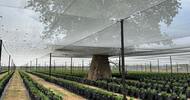The StarPhoenix | March 11, 2009
By Kevin Hursh
Large corporations are going to take over farming all the land. That fear has been expressed for decades, but in grain production the family farm remains supreme.
It must be noted that more and more family-owned operations are incorporated because that's the business structure that makes the most sense as an operation grows. And many family-owned operations are very large.
Statistically, an average farm in Saskatchewan has only about 1,500 cultivated acres. In practice, typical operations are 2,000 to 5,000 acres. And every year, there are more farms that encompass 10,000 and 20,000 acres and some are even larger.
As farms grow beyond 3,000 acres, they usually can't rely solely on family labour and therefore need a contingent of employees, especially during peak periods such as seeding and harvest.
While many farms have grown to become large entities, it has been rare to see an outside corporation jump into agriculture. That may be changing. With improved income prospects during the past few years, grain farming is looking more attractive.
There are now a few examples of outside corporations buying and/or leasing land and farming it themselves. In fact, a huge corporate farming entity is being planned for First Nations land in the three Prairie provinces.
Sprott Resource Corp., a Toronto-based company that invests in businesses in the natural resource sector, has announced the launch of One Earth Farms. Sprott says it will invest $27.5 million in One Earth Farms to establish operations, fund working capital and support initial growth.
The initial minimum target is 50,000 acres in the first year. The corporation says its access to large tracts of First Nations' farmland will position One Earth Farms to become the largest, most efficient farm in Canada.
The plan is to lease First Nations' land and initiate job training for First Nations to provide the labour. That's easy to say, but it will be much tougher to actually accomplish. It's unclear how many deals have actually been established.
The people at the helm do have impressive qualifications. Larry Ruud, a partner in Meyers Norris Penny, is also a director of Viterra. Blaine Favel is a former grand chief of the Federation of Saskatchewan Indian Nations. And Fred Siemens is a former president and CEO of the Winnipeg Commodity Exchange.
While the plan looks feasible on paper, it will face a number of daunting challenges. Most of the farmland belonging to First Nations is being leased to neighbouring family farms. Can an outside corporation provide better returns for the individual bands?
Size brings certain advantages, but will paid employees work as long and as hard as the owners of a family farm? Even more, will they forego good wages in the years when farming isn't so profitable?
While grain farming has resisted the typical corporate model, it's prevalent in other sectors such as hogs, where the rush to economies of size has been even more rapid.
A debate is raging in the U.S. over plans by President Barack Obama to limit the level of farm subsidies going to large farms. Obama's budget would phase out one type of subsidy to farmers who have annual sales of more than $500,000 a year. Total subsidy payments to any single farmer would be capped at $250,000 a year.
While the proposal seems to have strong support in the general public, farm organizations are vehemently opposed and it appears the proposal has little chance of passing Congress.
Here in Canada, opinion is divided on whether farm support programs should reward efficiency or be used as a tool to retain a larger number of individual enterprises that have a more moderate size.
Large farms are not always popular, but large farms set up by outside corporations are going to meet with limited public acceptance.
Kevin Hursh is a consulting agrologist and farmer based in Saskatoon. He can be reached at [email protected].
By Kevin Hursh
Large corporations are going to take over farming all the land. That fear has been expressed for decades, but in grain production the family farm remains supreme.
It must be noted that more and more family-owned operations are incorporated because that's the business structure that makes the most sense as an operation grows. And many family-owned operations are very large.
Statistically, an average farm in Saskatchewan has only about 1,500 cultivated acres. In practice, typical operations are 2,000 to 5,000 acres. And every year, there are more farms that encompass 10,000 and 20,000 acres and some are even larger.
As farms grow beyond 3,000 acres, they usually can't rely solely on family labour and therefore need a contingent of employees, especially during peak periods such as seeding and harvest.
While many farms have grown to become large entities, it has been rare to see an outside corporation jump into agriculture. That may be changing. With improved income prospects during the past few years, grain farming is looking more attractive.
There are now a few examples of outside corporations buying and/or leasing land and farming it themselves. In fact, a huge corporate farming entity is being planned for First Nations land in the three Prairie provinces.
Sprott Resource Corp., a Toronto-based company that invests in businesses in the natural resource sector, has announced the launch of One Earth Farms. Sprott says it will invest $27.5 million in One Earth Farms to establish operations, fund working capital and support initial growth.
The initial minimum target is 50,000 acres in the first year. The corporation says its access to large tracts of First Nations' farmland will position One Earth Farms to become the largest, most efficient farm in Canada.
The plan is to lease First Nations' land and initiate job training for First Nations to provide the labour. That's easy to say, but it will be much tougher to actually accomplish. It's unclear how many deals have actually been established.
The people at the helm do have impressive qualifications. Larry Ruud, a partner in Meyers Norris Penny, is also a director of Viterra. Blaine Favel is a former grand chief of the Federation of Saskatchewan Indian Nations. And Fred Siemens is a former president and CEO of the Winnipeg Commodity Exchange.
While the plan looks feasible on paper, it will face a number of daunting challenges. Most of the farmland belonging to First Nations is being leased to neighbouring family farms. Can an outside corporation provide better returns for the individual bands?
Size brings certain advantages, but will paid employees work as long and as hard as the owners of a family farm? Even more, will they forego good wages in the years when farming isn't so profitable?
While grain farming has resisted the typical corporate model, it's prevalent in other sectors such as hogs, where the rush to economies of size has been even more rapid.
A debate is raging in the U.S. over plans by President Barack Obama to limit the level of farm subsidies going to large farms. Obama's budget would phase out one type of subsidy to farmers who have annual sales of more than $500,000 a year. Total subsidy payments to any single farmer would be capped at $250,000 a year.
While the proposal seems to have strong support in the general public, farm organizations are vehemently opposed and it appears the proposal has little chance of passing Congress.
Here in Canada, opinion is divided on whether farm support programs should reward efficiency or be used as a tool to retain a larger number of individual enterprises that have a more moderate size.
Large farms are not always popular, but large farms set up by outside corporations are going to meet with limited public acceptance.
Kevin Hursh is a consulting agrologist and farmer based in Saskatoon. He can be reached at [email protected].













